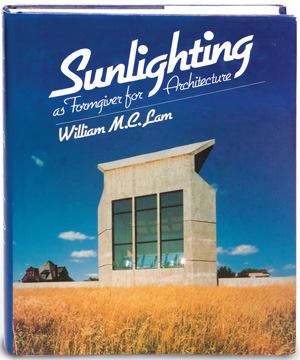Despite the fact that the topic of daylighting has become so prevalent in architectural and lighting design discussions and there is a wealth of written resources, there is no single title that has been recognized as the definitive reference on the subject matter. But one volume that comes close and has many lighting practitioners and daylighting specialists in agreement as being essential for a daylighting reference library is William M.C. Lam’s Sunlighting as Formgiver for Architecture.
Developed from illustrated lecture handouts created for a series of talks Lam presented to the U.S. Department of Energy, AIA Energy Inform, and Solar Energy Research Institute Passive Solar Commercial Buildings programs in the 1970s, the book’s relevance seems particularly timely today as a current generation of design practitioners tackle sustainable design and energy efficiency discussions.
Organized into two parts—design concepts and 25 case studies from Lam’s own lighting consulting practice—the most interesting component of Lam’s tome is his recasting of the discussion itself, from the subject of daylighting to sunlighting. As the book jacket describes, “Unlike daylighting, a primarily quantitative design approach that offers protection against the sun and is appropriate for climates with predominantly overcast skies (such as those of northern Europe), sunlighting is the positive control and utilization of the direct sunlight that is available in most parts of the worlds, including much of North America.” In reframing the topic, Lam tackles some of the nuances of technique lost in the broad reach of many a daylighting discussion. As Lam describes in a recent telephone interview with Architectural Lighting magazine, “We need to return to a greater understanding of our buildings. People are still not paying attention to site, orientation, or form. Rather, they are using technical means to solve building problems.” Lam always has been an advocate for developing lighting programs that reflect the specific needs and uses of a building, not simply relying on “numerical criteria.” This was the focus of his first book published in 1977, Perception and Lighting as Formgivers for Architecture. While some of the architectural project case studies in the Sunlighting book might seem a bit aesthetically dated according to today’s tastes, as sound examples of a core set of design principles for integrating sunlight into architectural spaces they remain as solid as ever. It is a title that should be considered essential reading for daylighting discussions and essential to the subject of lighting as a whole.
AUTHOR | William M.C. Lam
PUBLICATION DATE | 1986
PUBLISHER | Van Nostrand Reinhold Company, New York
PAGES | 464
AVAILABILITY | Out of print. However, the text is available for download on the author’s website at www.wmclam.com/publications.php
